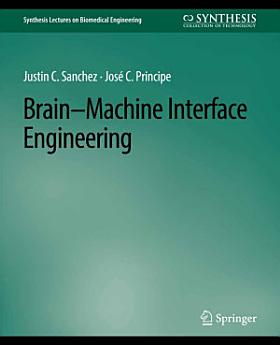Brain-Machine Interface Engineering
jún. 2022 · Springer Nature
Rafbók
234
Síður
reportEinkunnir og umsagnir eru ekki staðfestar Nánar
Um þessa rafbók
Neural interfaces are one of the most exciting emerging technologies to impact bioengineering and neuroscience because they enable an alternate communication channel linking directly the nervous system with man-made devices. This book reveals the essential engineering principles and signal processing tools for deriving control commands from bioelectric signals in large ensembles of neurons. The topics featured include analysis techniques for determining neural representation, modeling in motor systems, computing with neural spikes, and hardware implementation of neural interfaces. Beginning with an exploration of the historical developments that have led to the decoding of information from neural interfaces, this book compares the theory and performance of new neural engineering approaches for BMIs. Contents: Introduction to Neural Interfaces / Foundations of Neuronal Representations / Input-Outpur BMI Models / Regularization Techniques for BMI Models / Neural Decoding Using GenerativeBMI Models / Adaptive Algorithms for Point Processes / BMI Systems
Um höfundinn
Dr. Sanchez’s research interests are in Neural Engineering and neural assistive technologies. Topics include the analysis of neural ensemble recordings, adaptive signal processing, Brain-Machine Interfaces, motor system electrophysiology, treatment of movement disorders, and the neurophysiology of epilepsy. He is an Assistant Pro[1]fessor of Pediatrics, Neuroscience, and Biomedical Engineering at the University of Florida College of Medicine, Engineering, and McKnight Brain Institute in Gainesville, Florida. He received his Ph.D. (2004) and M.E. degrees in Biomedical Engineering and B.S. degree in Engineering Science (Highest Honors—2000) with a minor in Biomechanics from the University of Florida. The goal of his research is to develop state-of-the-art novel medical treatments by operating at the interface between basic neural engineering research and clinical care. This direction of research is motivated by the potential of direct neural interfaces for delivering therapy and restoring functionality to disabled individuals using engineering principles. In 2005, he won two prestigious awards for his work including Excellence in Neuroengineering and more recently an American Epilepsy Society Young Investigator Award. In 2006 he founded the Gainesville Engineering in Medicine and Biology/Communications Joint Societies Chapter and serves as the IEEE Gainesville Section Director for membership development. His neural engineering electrophysiology laboratory is currently developing direct neural interfaces for use in the research and clinical settings and has published over 35 peer review papers and holds 3 patents in neuroprosthetic design. He is the founding member of the Neuroprosthetics Group (NRG) at the University of Florida (http://nrg.mbi.ufl.edu).
Gefa þessari rafbók einkunn.
Segðu okkur hvað þér finnst.
Upplýsingar um lestur
Snjallsímar og spjaldtölvur
Settu upp forritið Google Play Books fyrir Android og iPad/iPhone. Það samstillist sjálfkrafa við reikninginn þinn og gerir þér kleift að lesa með eða án nettengingar hvar sem þú ert.
Fartölvur og tölvur
Hægt er að hlusta á hljóðbækur sem keyptar eru í Google Play í vafranum í tölvunni.
Lesbretti og önnur tæki
Til að lesa af lesbrettum eins og Kobo-lesbrettum þarftu að hlaða niður skrá og flytja hana yfir í tækið þitt. Fylgdu nákvæmum leiðbeiningum hjálparmiðstöðvar til að flytja skrár yfir í studd lesbretti.




